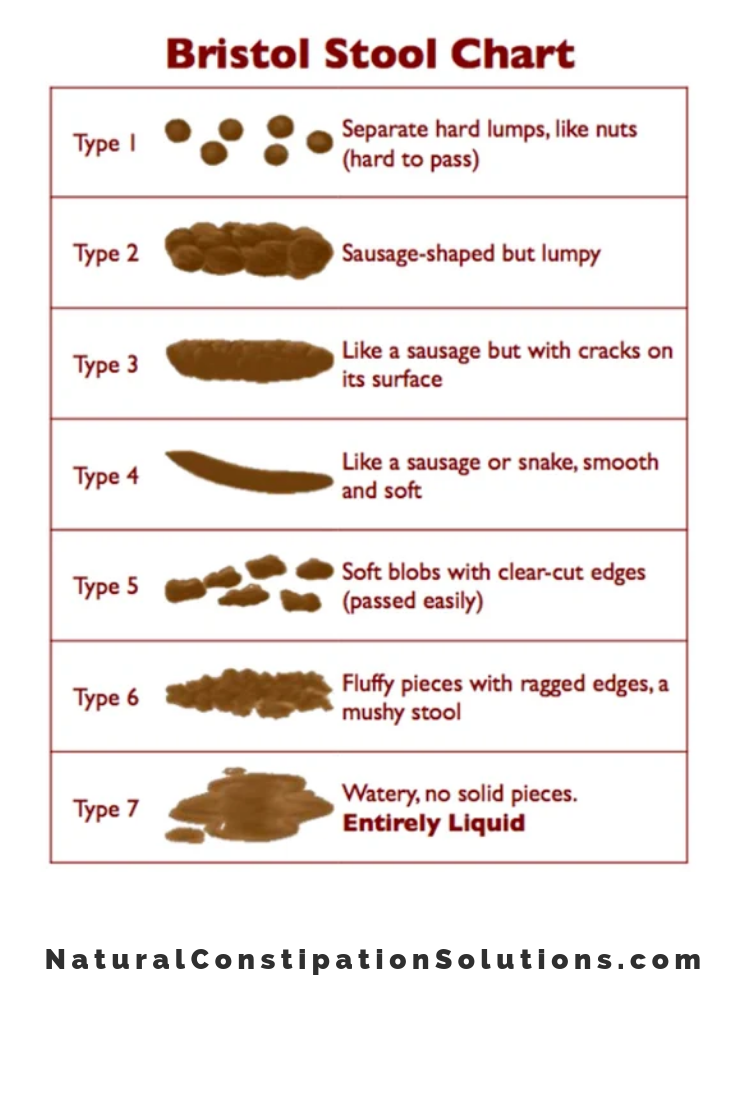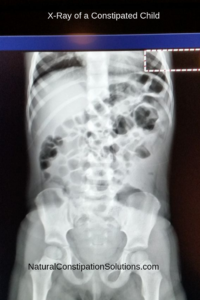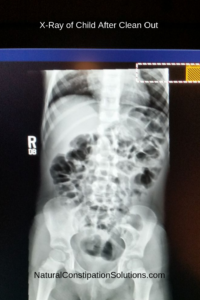The Bristol Stool Chart, Is My Child Constipated?
The Bristol Stool Chart – How to Tell if My Child Constipated?
How often should my child have a bowel movement?
Ideally, your child will be having a type 3 or 4 bowel movement, 1-3 times a day. Constipation is generally considered having less than three stools a week and having hard to pass stools. If your child is passing stools that look like type 1 or 2 on the Bristol Stool Chart, then he or she is constipated even if they are going daily or even multiple times a day.
Your child can also be passing type 5 or 6 stool and still be constipated! If your child has a hard ball of stool up in their intestines they can be passing soft to liquid stool that is seeping around the hard ball of stool.

Often it takes an X-Ray to determine the extent of your child’s constipation.
Signs of Constipation
Bloating, gas, large hard to pass stools, foul-smelling stools, a hard distended tummy, pain, cramping, straining when going, refusing to sit on the potty and requesting a pull-up or diaper for a bowel movement, red blood on the stool or when you wipe your child, or potty training regression can all be signs of constipation in children.
Breastfed infants can go much longer between bowel movements because breast milk is almost fully digested. Your breastfed baby can also have small frequent bowel movements even after every time they nurse. Either is normal. Your diet can have an impact on your breastfed babies bowel movements. Dairy, gluten, cruciferous vegetables, soy and corn in the mother’s diet can all cause constipation in certain babies.
If your baby is formula fed, their stools can be more difficult to pass and you are more likely to be dealing with constipation. Changing formulas can help in some cases.
For more information on infant constipation, please read my article, Safe Natural Constipation Solutions for Infants
Causes of Constipation
Common causes of constipation are diet and eating food that they are intolerant of or allergic to, dehydration, low magnesium, lack of fiber in the diet or too much fiber in the diet, a side effect of medication or antibiotics, lack of good gut bacteria, low tone, undiagnosed or under-treated hypothyroidism, Dairy, Celiac Disease or non-Celiac Gluten Sensitivity.
If you are unsure if your child is constipated, an X-ray can determine the level of constipation. If your pediatrician or Pediatric Gastroenterologist sends you to get your child X-rayed, it can be hard to know what to look for in the X-ray. Usually, the doctor will give you a report on what they saw in the X-ray but if you are sent off-site for the X-ray, it can take time to get the report. I am not an X-ray tech, but from what I have been told, the grey/white areas in the intestines are the stool and the darker black areas are gas/air. Below are examples of what an X-ray of a constipated child looks like and what an X-ray after the child has been cleaned out of stool look like.


My son had an X-ray to determine if he was constipated when he was 4 years old. He was having daily bowel movements and the stool was coming out very soft, a type 5 or 6 on the Bristol Stool Chart, but he seemed to be struggling. He was resistant to using the potty and would only go in his pull up. He would squat in a private corner to go. There would be behavior changes including tantrums, crying, hyperactivity, and listlessness prior to his going. He had been diagnosed with Celiac at 18 months and dairy intolerance from birth. I had him on a strict gluten free, dairy free diet but something was still wrong. His pediatrician referred us to a Pediatric Gastroenterologist at a prestigious teaching hospital 2 hours from our home.
After an exam and an X-ray, the Pediatric Gastro said that my son had a hard mass of stool high up in his intestines and the stool that we were seeing come out, was actually leaking around the hard mass. He also diagnosed my son with Megacolon from the X-Ray. Megacolon is a large stretched out intestine. It can be caused by chronic constipation or it can be a birth defect like my son’s was, where the nerves didn’t travel down the intestines properly during the first trimester of pregnancy.
Based on the X-Ray, the Pediatric Gastro recommended that we do a Miralax cleanout and then daily doses of Miralax for maintenance. I questioned the safety of Miralax but the Pediatric Gastro assured me that is was “Safe as Water” and “Not absorbed.” The Pediatric Gastroenterologist was the head of Pediatric Gastroenterology at a well-respected teaching hospital so I trusted him.
Unfortunately, Miralax caused horrible side effects in my son and was the beginning a nightmare that I hope no other families have to go through which is why I started my website.
As I did research, I discovered that many children were suffering horrible side effects from Miralax including, Rage, Aggression, OCD, ADD, Tics, Seizures, Panic Attacks, Kidney problems, Autism-like behaviors, ODD, Night Terrors, Learning Delays, Mouth Sores, Lack of Growth, Hallucinations, Speech Issues, and Numbness. If you are concerned about Miralax and would like to learn about my son’s story and the stories of many other children who suffered serious side effects from Miralax, please read Is Miralax Safe to Give to My Child?
If your child is constipated and you need to do a clean out, my article How to do a Clean Out for Your Constipated Child will guide you through the process of getting all of the backed up stool out of your child and help you to get a fresh start.
How to Help Your Child Poop Regularly
To get your constipated child to have a bowel movement, Magnesium is generally a safe and effective choice. Magnesium Citrate and Magnesium Oxide (Milk of Magnesia) were commonly prescribed for constipation and clean outs prior to the invention of Miralax. For short-term use in children over 4, Natural Calm Magnesium is very effective and generally well tolerated by children. In infants and children under 4, Omniblue Ocean Minerals is a safe and effective product to get a bowel movement.
Most people are magnesium deficient. Blood tests for magnesium only show what is in the blood which is less than 1% of the total magnesium in your body and really doesn’t give a very good picture of your child’s needs. The RDA for magnesium is what is needed to not have serious side effects of magnesium deficiency. Not what you need to be optimal.
Each child is different, and what they will need to be optimal is different, especially if they have been deficient for years. It will take a long time to build up their stores of magnesium. Dosing will be trial and error as you figure out what works best for your child. It may change over time as your child’s magnesium stores fill up. You are looking to dose to the point of 1-3 soft easy-to-push-out stools a day, ideally once after each meal. If you aren’t trying to do a clean out and your child gets loose stools, then back off on the dose. If your child has hard, painful stools, increase the dose.
When your child is chronically or functionally constipated, it is frustrating and exhausting for both you and your child. It can also be very hard to figure out what interventions are helping to overcome their constipation and what regiment needs to be followed to help them go 1-3 times a day.
It is very helpful to track what you are giving your child and how it is working. It seems like you will remember how much magnesium or how many Chocolate Coconut Oil Poop Candies your child had last Tuesday when they had 2 great BMs, but the reality is that it is very hard to remember everything when you are stressed about your child’s constipation.
To make it easier for you to track the interventions you are using and what impact this regiment has, I want to offer you a free bowel movement tracker chart that you can download and then print off for each week. It will help keep you organized and will give you insight into what works to help you overcome your child’s constipation.
Click on this link and sign up to receive a Free Bowel Movement Tracker Chart to help you find a plan to manage your child’s constipation.
Implementing a “Try Time” 20-30 minutes after each meal can be a wonderful help in getting your child to get on a routine of going and having daily bowel movements. Have them sit on the potty for 5-10 minutes and see if they can go. If they can’t, it’s ok. Tell them you are pleased that they tried and then try again after the next meal. You don’t want them to sit and try for too long as this can contribute to hemorrhoids and can make your child more resistant to trying to go in the future.
If your child’s stools are hard and painful to pass, coconut oil can be a wonderful way to lubricate the stools and help them pass. Some children will eat coconut oil off of a spoon but if your child won’t, or you are looking for a tasty way to increase their coconut oil consumption, my recipe for Chocolate Coconut Oil “Poop Candy” can be a treat and very effective in producing a bowel movement.
My children’s book, Dash’s Belly Ache, is a book for children who can’t or won’t poop. The star of the book is Dash, a border collie pup who won’t poop. His doctor gives him a special treat in the book that helps him to have a bowel movement. The recipe for the treat is in the book and also in this article. If your child is struggling with constipation, withholding or is resistant to pooping, Dash’s Belly Ache is a helpful tool to add to your arsenal to help them overcome their struggle. You can buy Dash’s Belly Ache on Amazon.
If your child is chronically constipated, my article How Do I Solve My Child’s Chronic Constipation? will help you to get a game plan to get them going daily and will help you to solve their constipation long term.
For support and information on constipation and safe alternatives, please consider joining the Facebook groups People Against Miralax or Natural Constipation Solutions.
This post contains affiliate links
*DISCLAIMER, I AM NOT A DOCTOR OR MEDICAL HEALTH PROFESSIONAL. ALL IDEAS DISCUSSED AND DESCRIBED IN THIS POST ARE MY OWN AND ARE NOT MEANT TO TREAT OR DIAGNOSE. IF YOU HAVE A MEDICAL CONDITION PLEASE SPEAK WITH YOUR DOCTOR.



